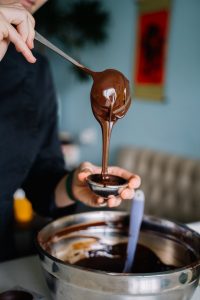This Is The Secret Ingredient That Makes Chocolate So Delicious
 The chocolate traditional, we found in supermarkets, is made by corporations, mixing low quality cocoa beans, then adding a large amount of sugar, vanillin, cocoa butter and emulsifiers such as soya lecithin to ensure that the taste and texture always be the same. What we think chocolate tastes like is usually just sugar and vanilla.
The chocolate traditional, we found in supermarkets, is made by corporations, mixing low quality cocoa beans, then adding a large amount of sugar, vanillin, cocoa butter and emulsifiers such as soya lecithin to ensure that the taste and texture always be the same. What we think chocolate tastes like is usually just sugar and vanilla.
The product, made in this way, is named industrial chocolate. And we ate it, so we know it’s not all bad. Generally, most people like chocolate and differ only in preferences. For example, if it is sweeter, more bitter, milk, with nuts, walnuts, cookies, raisins, and various other combinations.
Chocolate
Whatever the format, chocolate is one of the most consumed foods in the world. However, even the most chocoholic may not know that this ancient food has one thing in common with kimchi and kombuchá. The fact that the flavor comes from fermentation.
Chocolate’s familiar taste is produced by tiny microorganisms that help transform raw ingredients into the complex final product. And self-proclaimed chocolate scientists are working, in laboratories in Peru, Belgium and even Côte d’Ivoire, to understand how this fermentation changes the taste of chocolate.
To do this, they sometimes create artificial fermentations in laboratories. And other times they taste the cocoa beans fermented by nature. But often, they turn the experimental batches into chocolates and ask volunteers to taste them and tell researchers what flavors they can detect.
The researchers managed to solve, after decades of testing, several mysteries surrounding cocoa fermentation. For example, the microorganisms involved and how this step interferes with the taste and quality of chocolate.
Fermentation
 The well-known chocolate begins its life in the form of seeds in the shape of a football. They grow directly from the trunk of the Theobroma cacao tree .
The well-known chocolate begins its life in the form of seeds in the shape of a football. They grow directly from the trunk of the Theobroma cacao tree .
And 3,900 years ago, Central America’s Olmecs developed a multi-step process to successfully turn these giant-seeded fruits into an edible delicacy.
First the fruit is opened and its seeds and pulp are removed. The seeds, then called grains, are cured and left to drain for three to 10 days before being allowed to dry in the sun.
With the beans already dry, they are roasted and then kneaded with sugar and sometimes with powdered milk until this mixture is homogeneous. When this point is reached, the chocolate is ready to be transformed into bars, cookies or chocolates.
It is during the curing phase that fermentation takes place naturally. And chocolate’s complex flavor consists of hundreds of individual compounds. Several of them are generated during fermentation.
This fermentation is the process of enhancing the qualities of a food through the controlled activity of microbes. And it allows bitter or tasteless caca beans to develop rich chocolate-related flavors.
Flavor
All reactions that are caused by acetic acid bacteria have a big impact on taste. Also because it is these acids that break down polyphenol molecules, which have a deep violet color and are quite astringent, into brown chemicals with a milder taste, which are known as o-quinones.
This is when the cocoa beans stop having a bitter taste and start having a rich, nutty flavor. Along with the flavor transformation, the color transformation also takes place, going from a reddish purple to brown.
…